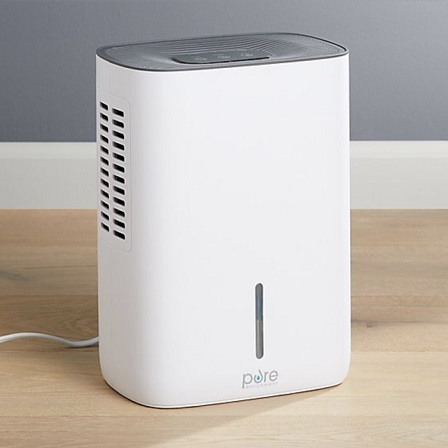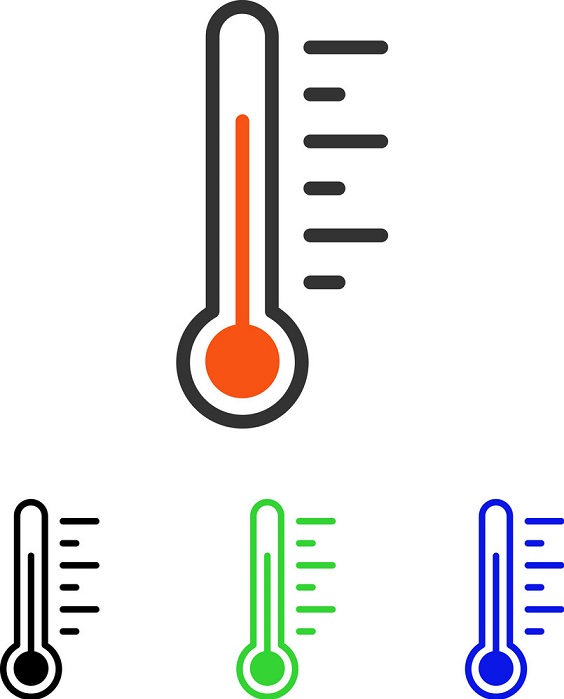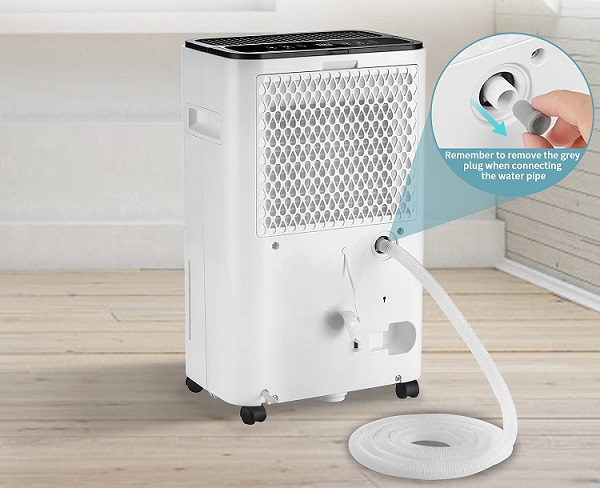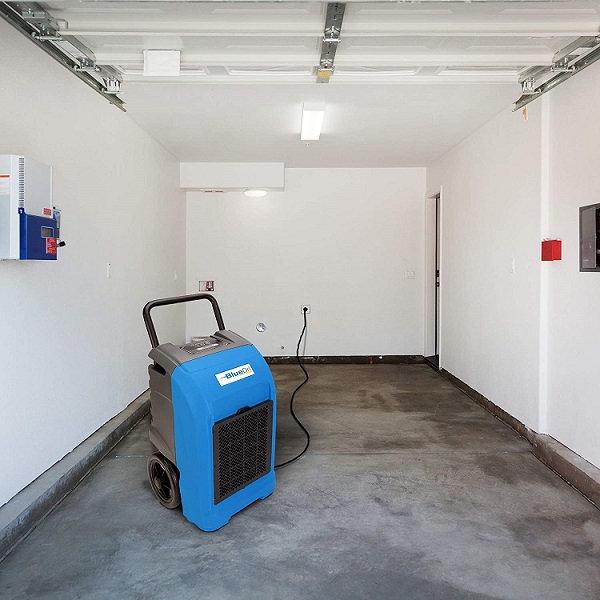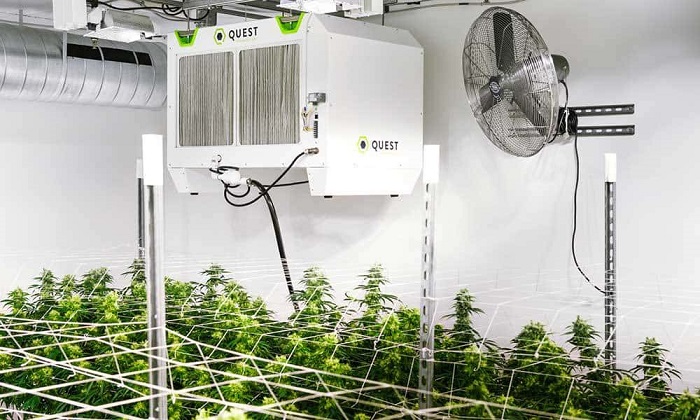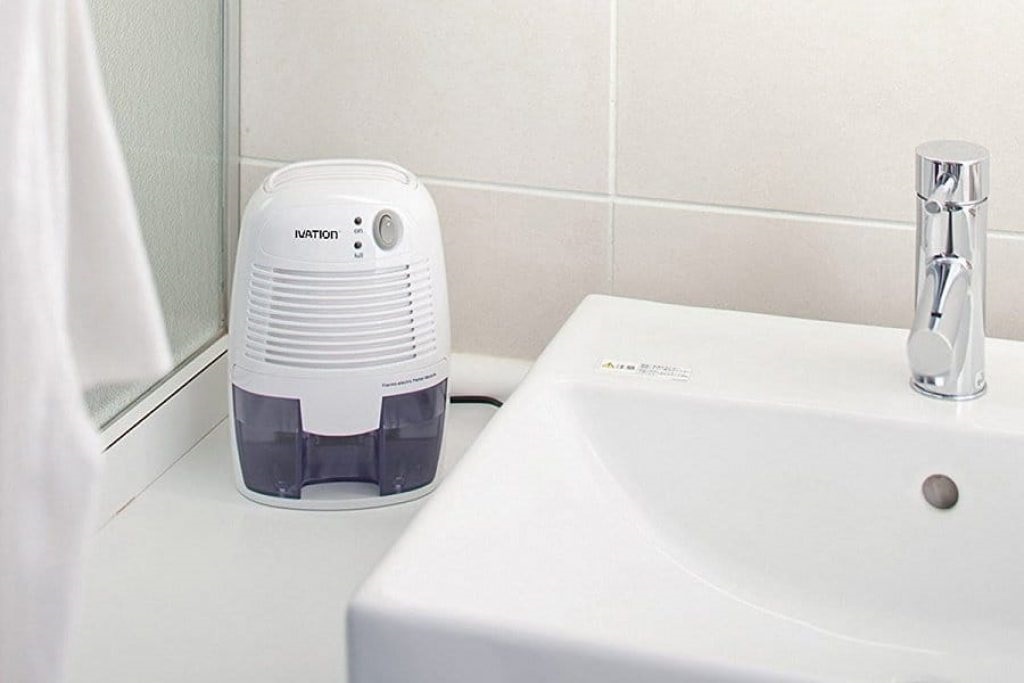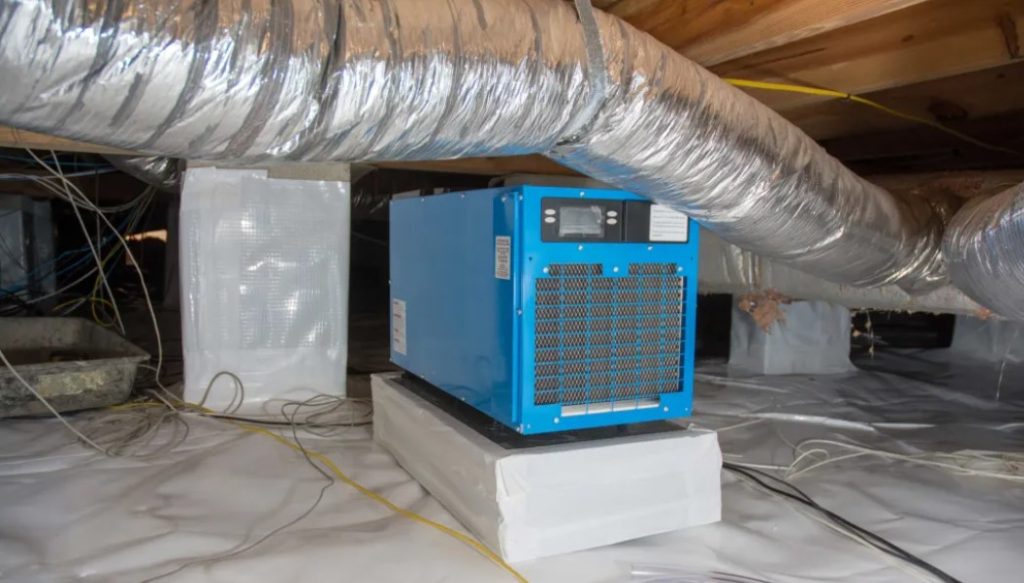A dehumidifier is an essential equipment if you live in a locality with high humidity levels. They are helpful to deal with several issues like mold outbreak and muggy air.
However, if the dehumidifier is too big or too small for the space, then it cannot deliver the results. In addition to that, you will experience higher electricity costs if the appliance is too big for the room.
So, it is very important to check if the capacity of dehumidifier is suitable for your room or area where it is placed.
If you are unaware of how to choose the right sized dehumidifier, then you have come to the right place. Here, we have explained all the factors and details you have to consider while analyzing the options.
Outline
ToggleHow Are Dehumidifiers Sized?
The size of a dehumidifier is determined by its capacity of removing moisture or dehumidifying the area. Capacity of a dehumidifier is measured in pints of moisture per day (24-hour period).
In simple terms, capacity represents how much space it can cover in square feet. If you know how much space you want to dehumidify, then you can estimate the amount of capacity that you will need.
For instance, if you see a 30-pint dehumidifier, it means that the unit is rated to remove 30 pints total moisture per day under testing conditions. The new testing conditions are 65°F and 60% humidity. Dehumidifiers used to be tested at 60 degrees F and 80% humidity. However, those standards were changed in 2020 according to changes in environment or climatic conditions.
How to Pick the Right Size Dehumidifier?
While purchasing a dehumidifier, you have to consider the below-mentioned three factors.
- Area of the space/room
- Relative humidity level
- Average temperature inside the room/space
Below, let us explore each factor in more depth and detail.
1. Size of the Room
When choosing a dehumidifier, the biggest factor is the size of the space. The dehumidifier will be more efficient if the space is larger.
To determine the size of your room, you’ll need to measure it. Measure the space with a tape measure and multiply it by the length and width to determine the square footage. For rounding, you will only need an approximate number. A small space measuring 10 feet in width and 10 feet long will have 100 square feet, or (9.3m2). This is how it works:
Room Size = Length X Width
You should also consider the airflow your dehumidifier will provide for large spaces. We have created a handy chart to help you narrow down your search. This chart will help to choose the right dehumidifier size.
Note: To determine the room’s capacity, compare the area of your room to the humidity levels in the room. You’ll need a dehumidifier for larger areas such as basements, crawl spaces, and whole houses. This will depend on how tight or loosely sealed your home is.
| Room Size (sq ft) | Dehumidifier Size (Pints) |
| 400 sq ft | 25 pints |
| 500 sq ft | 30 pints |
| 600 sq ft | 35 pints |
| 800 sq ft | 45 pints |
| 900 sq ft | 50 pints |
| 1,000 sq ft | 55 pints |
| 1,200 sq ft | 60 pints |
| 1,500 sq ft | 65 pints |
| 2,000 sq ft | 70 pints |
| 2,500 sq ft | 80 pints |
2. Relative Humidity Level
The relative humidity within the space is the most obvious thing to consider. A room that is very damp might require a larger dehumidifier. A room that is “just a bit damp” might require a slightly smaller dehumidifier.
Before you choose a humidifier, I recommend that you use a hygrometer. Sometimes it can be difficult to determine the humidity based on just feeling. It’s why it is important to measure.
If not, you can consider the below representation. These are the three levels of a living room that are too humid. How to adjust your dehumidifier accordingly.
- Somewhat Damp: It represents moisty feeling, visible light moisture on windows and a musty odor – Add 2-3 pints of water to each 500-square-foot area.
- Wet – Water beading on walls, ceilings or windows; an obvious “wet” feeling or traces of mold and mildew formation – Add 4-5 pints of water to the capacities in the charts for every 500 square feet.
- Very wet – For every 500 square feet, add 6-7 pints of water to the capacities in the charts above.
Other humidity considerations to be aware of when deciding the size dehumidifier for your home are:
- Add 10 pints to your dehumidifier size if you live in very humid areas like the south and southeast US. A 45-pint unit is recommended for drying 800 square feet. To ensure that the space is comfortable, use a 55-pint dehumidifier.
- Add 5 pints to the dehumidifier if there are more people than 5 living in the apartment or house.
- Add 5 pints to the dehumidifier if the space contains many windows or exterior doors.
- Add 5 pints to the dehumidifier if there are washers and dryers nearby.
3. Temperature Levels Within the Room
The temperature in the room is also important to consider while analyzing the required dehumidifier size. Higher temperatures make dehumidifiers more effective. Low temperatures are not a good environment for dehumidifiers. A larger dehumidifier is required if you are going to dehumidify a cold area.
Refrigerant dehumidifiers can work at temperatures below 41 degrees F. However, if the room is below 41 degrees F, it won’t work as well. Your dehumidifier’s performance will be affected by the temperature of the surrounding area.
How to Calculate the Right Dehumidifier Size?
Once you have determined the size, humidity and temperature levels, you can calculate the right size for you. Below, we have provided standard values considered for analyzing the size of a dehumidifier.
To find out the correct size of dehumidifier, there are two dehumidifier sizing standards set by the Department of Energy for the convenience of the consumers.
- Old Standard from 2012
- New standard from 2020
A dehumidifier shows both the standards on its label for a consumer to determine if the size of the dehumidifier is perfect. For example, you will come across a dehumidifier labeled as “Brand Model-Number Dehumidifier New 50 Pint-2019 DOE (Old 70 Pint)”.
This means that according to the new standard, the size of the dehumidifier is 50 pints while according to the old standard, the size is 70 pints. You must be wondering how a dehumidifier could have two different sizes. For that, you have to understand the differences between Old and New Dehumidifier Sizing Standards.
Difference Between Old and New Dehumidifier Sizing Standards –
The old standard takes into account the energy factor while the new standard takes into account the integrated energy factor. Besides, the old standard takes test temperature at 80-degree Fahrenheit while the new standard takes test temperature at 65-degree Fahrenheit.
Experts believe that the integrated energy factor is more accurate while the manufacturers believe that the old standard is correct. That is why both the standards are mentioned in dehumidifiers. Here is a chart that shows the correct dehumidifier size (old and new standards) for a 500 sq. ft. area of a room based on the average humidity level.
Quick Guide For Choosing the Right Dehumidifier
| Humidity Levels: | 300 sq ft space | 500 sq ft space | 800 sq ft space | 1,200 sq ft space |
| 50-60% Humidity (Air feels slightly heavy) |
30 Pint (Old Standard) 20 Pint (New Standard) |
45 Pint (Old Standard) 30 Pint (New Standard) |
60 Pint (Old Standard) 40 Pint (New Standard) |
70 Pint (Old Standard) 50 Pint (New Standard) |
| 60-70% Humidity (Occasional musty smell) |
30 Pint (Old Standard) 20 Pint (New Standard) |
45 Pint (Old Standard) 30 Pint (New Standard) |
60 Pint (Old Standard) 40 Pint (New Standard) |
70 Pint (Old Standard) 50 Pint (New Standard) |
| 70-80% Humidity (Wet spots on the walls, windows and floor) |
40 Pint (Old Standard) 25 Pint (New Standard) |
50 Pint (Old Standard) 30 Pint (New Standard) |
65 Pint (Old Standard) 45 Pint (New Standard) |
80 Pint (Old Standard) 55 Pint (New Standard) |
| 80-100% Humidity (Seepage on walls) |
45 Pint (Old Standard) 30 Pint (New Standard) |
60 Pint (Old Standard) 40 Pint (New Standard) |
70 Pint (Old Standard) 50 Pint (New Standard) |
90 Pint (Old Standard) 60 Pint (New Standard) |
Let us help you in calculating the right size based on the metrics and standard values provided in the above table.
For instance, let us a home area of 1200 Sq Ft that has 65% relative humidity and average temperature of 70°F. So, by checking the tables, the dehumidifier you have to choose is 70 pints according to old standard and 50 pints according to new standard.
What Size of Dehumidifier is Suitable for Basement?
It can be difficult to find the right basement dehumidifier due to differences in size and humidity. Usually, some basements are large while others are small, so it is difficult to recommend a basement humidifier.
For instance, we recommend a 45-pint humidifier (2020 standard) for a basement of average size (800 sq.ft). A dehumidifier that has a drain spout is a good option if you have a basement that needs to be constantly dehumidified.
It allows you to connect a drain line to your dehumidifier, allowing it to continuously empty the drain. You no longer need to empty the tank of your dehumidifier every day.
What Size of Dehumidifier for Garage?
It is easy to find a garage dehumidifier because most garages are roughly the same size. You’d need around 400 sq.ft. to build a 2-car garage. You have approximately 400 sq. ft. If the humidity level is 70% or less, you will need a 25-pint humidifier (2020 standard).
Temperature of your garage is the most important factor to consider. A larger dehumidifier is needed if it is cold in your garage. This is why I recommend a larger dehumidifier to your garage.
What Size of Dehumidifier for Grow Room?
You will need to make some calculations in order to determine the size of your room’s dehumidifier. How much water do you give your plants every day? If you have 20 plants in your garden and water it with 1 gallon per day, then you’ll have 20 gallons of moisture.
Dehumidifiers are rated by pints. To convert from gallons to pints, multiply the amount of water you give your plants every day by an 8-factor. This will yield 160 pints of moisture that you will need to remove.
To calculate the average daily watering rate for soil plants, divide the total pints of water by 2.
Suitable Size =Number of plants x gallons you water per plant x 8 (gallon to pint standard calculation)
What Size of Dehumidifier For Bathroom?
A small peltier dehumidifier is sufficient for most bathrooms. A dehumidifier for the bathroom is a smart choice, as it can be drained directly into the sink.
An exhaust fan may be a better option for excessive moisture problems in your bathroom to reduce humidity after a shower. A bathroom exhaust fan can quickly remove any moist air and bring the humidity back to its original level before you took a hot shower.
What Size of Dehumidifier for Crawl Space?
Crawl space dehumidifiers typically have a rating of 70 pints or more. A 70-pint dehumidifier will dehumidify a crawlspace in a home of average size (1500-2500 sq. ft.)
Crawl space humidifiers are unique because they can be used 24/7. They all require some installation. Mounting your crawl space humidifier is a must. You can either hang it from the floor joists, or place it on cinder block.
Next, you will need to install flex ducts to distribute air throughout your crawl space. This is important because your dehumidifier requires adequate airflow coverage in order to dehumidify large spaces.
Crawl space dehumidifiers do not have an internal tank. To drain the dehumidifier, you will need to run a condensate drain pipe outside.
Some Frequently Asked Question
30-Pint dehumidifier – This size is recommended for areas of up to 1500 square feet. This means that it is suitable for most residential basements.
50-pint dehumidifier would be needed if your basement is 500 square feet and the humidity is medium (70% to 80%). This is a rough estimate. Some producers may use numbers such as 3,000 sq. ft. or 4,500 sq. ft.
Most of the dehumidifiers come with a humidistat that measures the ambient humidity. While an excessively large dehumidifier may cause your home to dry quickly, it should be turned off once the desired humidity level is reached. Without this measurement and control, the dehumidifier might be too big for the space. You might need a humidifier to reverse the drying effect.
Some brands provide whole-house dehumidifier, you can choose these models. These products can cover a large area, up to 5,000 feet, which allows them to condition the air throughout your home.
The dehumidifier should not be left on constantly. It is unnecessary and can cause breathing problems such as bronchitis or sinusitis, asthma, nosebleeds, and other conditions.
The frequency at which the dehumidifier is emptied depends on how frequently it runs. A dehumidifier should normally be empty twice daily, but some homes may only need to empty it once every two days. To get an idea of the time it takes for the bucket to fill up, be sure to check the dehumidifier before it’s set up.
Conclusion
It is a known fact that a dehumidifier is helpful in decreasing humidity levels in a room or house. But to achieve its effectiveness, you have to invest in a model that is appropriate for the room you are placing. If the model is either too big or too small, you cannot experience its effectiveness. In fact, ft the model is too big, then you will have to deal unpleasant side effects like dry nose, dry skin, dry eyes and others.
In order to choose the right size, you can follow the instruction mentioned in this article. We have carefully crafted the information to help you make the right decision.
If you still have any doubts, write to us in the comment section below. We will reply to your queries at the earliest convenience.

